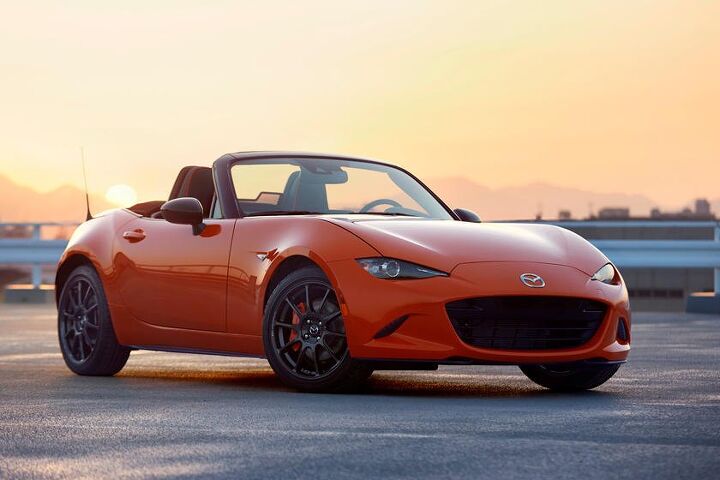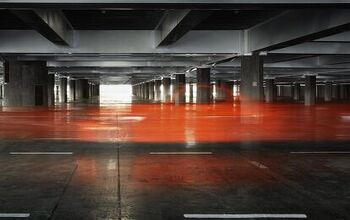Chicago Celebration: Mazda MX-5 30th Anniversary Edition

Mazda is celebrating the original Miata’s 1989 debut at the Chicago Auto Show by taking the wraps off a 30th Anniversary Edition of the MX-5 at the same locale. Limited to just 3,000 units worldwide, the special edition will be offered as both the ragtop convertible and hardtop RF. Like previous anniversary editions of the famous roadster, Mazda is offering a unique color (Racing Orange, this time) and a handful of upgrades that should help collectors rationalize the elevated price tag.
We’re going to tell you right now that the only way to have this car is with a manual transmission. While we tend to always lean that way with the MX-5, having a clutch is the only way to get the 30th Anniversary Edition’s Bilstein dampers and a mechanical limited-slip differential. Otherwise, you’re basically paying extra to have one of the best parts of the package removed from the vehicle.
However, the automatic version still comes with the orange pant — which extends to the vehicle’s brake calipers (front Brembo units and Nissins in the rear), heated Recaro seats, door trim, dashboard, and shifter. It also gets the same commemorative badging, black mirrors, nine-speaker Bose audio system, and 17-inch aluminum wheels from Rays.
While we would have loved to see a few extra ponies crammed under the hood, Mazda upgraded the Miata’s 2.0-liter SkyActiv engine to 181 horsepower a few months ago. It would be a pretty big ask to have them go even bigger on this special edition, so we won’t complain. The standard engine is more than enough for track-day fun and backroad hooliganism.
With only 500 examples coming into the United States, pricing for the Mazda MX-5 30th Anniversary Edition begins at $34,995 for a soft-top with the manual. Going with the very handsome RF will bring that sum up to $37,595 and optioning the six-speed automatic carries a $500 premium. While it is one hundred bucks cheaper to have the clutch removed on the ragtop, we still think having those dampers and the differential is the way to go.
Or, you could always just buy a base Miata for $25,730, use the savings to modify it six ways from Sunday, and chuck on a coat of orange paint yourself.
[Images: Mazda; © 2019 Tim Healey/TTAC]

A staunch consumer advocate tracking industry trends and regulation. Before joining TTAC, Matt spent a decade working for marketing and research firms based in NYC. Clients included several of the world’s largest automakers, global tire brands, and aftermarket part suppliers. Dissatisfied with the corporate world and resentful of having to wear suits everyday, he pivoted to writing about cars. Since then, that man has become an ardent supporter of the right-to-repair movement, been interviewed on the auto industry by national radio broadcasts, driven more rental cars than anyone ever should, participated in amateur rallying events, and received the requisite minimum training as sanctioned by the SCCA. Handy with a wrench, Matt grew up surrounded by Detroit auto workers and managed to get a pizza delivery job before he was legally eligible. He later found himself driving box trucks through Manhattan, guaranteeing future sympathy for actual truckers. He continues to conduct research pertaining to the automotive sector as an independent contractor and has since moved back to his native Michigan, closer to where the cars are born. A contrarian, Matt claims to prefer understeer — stating that front and all-wheel drive vehicles cater best to his driving style.
More by Matt Posky
Latest Car Reviews
Read moreLatest Product Reviews
Read moreRecent Comments
- Jalop1991 In a manner similar to PHEV being the correct answer, I declare RPVs to be the correct answer here.We're doing it with certain aircraft; why not with cars on the ground, using hardware and tools like Telsa's "FSD" or GM's "SuperCruise" as the base?Take the local Uber driver out of the car, and put him in a professional centralized environment from where he drives me around. The system and the individual car can have awareness as well as gates, but he's responsible for the driving.Put the tech into my car, and let me buy it as needed. I need someone else to drive me home; hit the button and voila, I've hired a driver for the moment. I don't want to drive 11 hours to my vacation spot; hire the remote pilot for that. When I get there, I have my car and he's still at his normal location, piloting cars for other people.The system would allow for driver rest period, like what's required for truckers, so I might end up with multiple people driving me to the coast. I don't care. And they don't have to be physically with me, therefore they can be way cheaper.Charge taxi-type per-mile rates. For long drives, offer per-trip rates. Offer subscriptions, including miles/hours. Whatever.(And for grins, dress the remote pilots all as Johnnie.)Start this out with big rigs. Take the trucker away from the long haul driving, and let him be there for emergencies and the short haul parts of the trip.And in a manner similar to PHEVs being discredited, I fully expect to be razzed for this brilliant idea (not unlike how Alan Kay wasn't recognized until many many years later for his Dynabook vision).
- B-BodyBuick84 Not afraid of AV's as I highly doubt they will ever be %100 viable for our roads. Stop-and-go downtown city or rush hour highway traffic? I can see that, but otherwise there's simply too many variables. Bad weather conditions, faded road lines or markings, reflective surfaces with glare, etc. There's also the issue of cultural norms. About a decade ago there was actually an online test called 'The Morality Machine' one could do online where you were in control of an AV and choose what action to take when a crash was inevitable. I think something like 2.5 million people across the world participated? For example, do you hit and most likely kill the elderly couple strolling across the crosswalk or crash the vehicle into a cement barrier and almost certainly cause the death of the vehicle occupants? What if it's a parent and child? In N. America 98% of people choose to hit the elderly couple and save themselves while in Asia, the exact opposite happened where 98% choose to hit the parent and child. Why? Cultural differences. Asia puts a lot of emphasis on respecting their elderly while N. America has a culture of 'save/ protect the children'. Are these AV's going to respect that culture? Is a VW Jetta or Buick Envision AV going to have different programming depending on whether it's sold in Canada or Taiwan? how's that going to effect legislation and legal battles when a crash inevitibly does happen? These are the true barriers to mass AV adoption, and in the 10 years since that test came out, there has been zero answers or progress on this matter. So no, I'm not afraid of AV's simply because with the exception of a few specific situations, most avenues are going to prove to be a dead-end for automakers.
- Mike Bradley Autonomous cars were developed in Silicon Valley. For new products there, the standard business plan is to put a barely-functioning product on the market right away and wait for the early-adopter customers to find the flaws. That's exactly what's happened. Detroit's plan is pretty much the opposite, but Detroit isn't developing this product. That's why dealers, for instance, haven't been trained in the cars.
- Dartman https://apnews.com/article/artificial-intelligence-fighter-jets-air-force-6a1100c96a73ca9b7f41cbd6a2753fdaAutonomous/Ai is here now. The question is implementation and acceptance.
- FreedMike If Dodge were smart - and I don't think they are - they'd spend their money refreshing and reworking the Durango (which I think is entering model year 3,221), versus going down the same "stuff 'em full of motor and give 'em cool new paint options" path. That's the approach they used with the Charger and Challenger, and both those models are dead. The Durango is still a strong product in a strong market; why not keep it fresher?










































Comments
Join the conversation
ghastly colour on a really nice car. but they're sold out so no worries.
I remember 30 years ago, driving my then RX-7 to a small, local dealer to check out the first Miata. Today's car is what I expect, and it's just beautiful. And I like the orange! Bright colors do the car well.